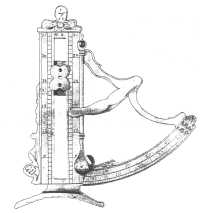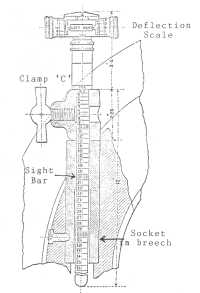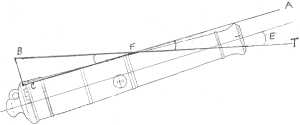The Gun - Smoothbore Era 1550-1860: Sights and Laying | |
Tangent Sight in the Smoothbore Era | |
The tangent sight made the layer's job much easier because he could lay for both line and elevation simultaneously, but it was some time before it was generally accepted. Although invented c1779 few guns were fitted with it before 1800 owing to traditional opposition to new-fangled ideas. When offered the new sight, Nelson said he 'would not look at it' but felt the Royal Navy did not need sights because they always closed to within point blank range before opening fire. Before the appearance of the tangent sight attempts were made to modify the level and/or the perpendicular to apply elevation by placing it fore and aft upon the centre line at the breech (after the line had been found) and after making any adjustment for taper in the barrel. Laying in this manner wasn't very satisfactory but no doubt was more convenient than using the Gunners Quadrant at the muzzle. A rigid plummet instead of plumb line and bob was sometimes used. Spirit levels instead of plumb line etc were tried late in the 17th century but owing to their cost were not generally adopted until much later. |
 German brass Gunners level with central sliding sight. The latter resembles a tangent sight but the design appears to be based on Tartaglia's erroneous assumption that equal increments of elevation achieved equal increments of range. Made c. 1700.
|
The original consisted of a simple open sight on a bar graduated in ranges or degrees and inserted into a socket in the breech with a suitable clamp. In some guns the socket was provided in the centre of the breech, in others on both sides. Earlier sights had no deflection scale. The name derives from the fact that the height to which the backsight must be raised to give the gun the required angle of elevation is obtained by multiplying the tangent of this angle by the distance between the backsight and foresight, or as generally expressed, the radius distance. The tangent sight in the form shown survived as the principle method of laying field guns in the British Army (in both smooth-bore and rifled guns) until the South African War (1899 - 1902). It was invented in England c1779 but was fitted to few guns before 1800. |
 Tangent Sight |
 |
Let B = backsight C = clamp for sight bar BC E = elevation on gun F = foresight CF = radius distance. Then BFC = AFT = E and BC/FC = tan E. Therefore BC = FC tan E hence the name 'tangent sight'. |
|
WL Ruffell previous | index | next | History Home Page | Old Comrades' Home Page | |